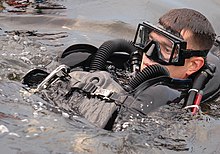
Rebreather diving is underwater diving using diving rebreathers, a class of underwater breathing apparatus which recirculate the breathing gas exhaled by the diver after replacing the oxygen used and removing the carbon dioxide metabolic product. Rebreather diving is practiced by recreational, military and scientific divers in applications where it has advantages over open circuit scuba, and surface supply of breathing gas is impracticable. The main advantages of rebreather diving are extended gas endurance, low noise levels, and lack of bubbles.[1]
Rebreathers are generally used for scuba applications, but are also occasionally used for bailout systems for surface-supplied diving. Gas reclaim systems used for deep heliox diving use similar technology to rebreathers, as do saturation diving life-support systems, but in these applications the gas recycling equipment is not carried by the diver. Atmospheric diving suits also carry rebreather technology to recycle breathing gas as part of the life-support system, but this article covers the procedures of ambient pressure diving using rebreathers carried by the diver.
Rebreathers are generally more complex to use than open circuit scuba, and have more potential points of failure, so acceptably safe use requires a greater level of skill, attention and situational awareness, which is usually derived from understanding the systems, diligent maintenance and overlearning the practical skills of operation and fault recovery. Fault tolerant design can make a rebreather less likely to fail in a way that immediately endangers the user, and reduces the task loading on the diver which in turn may lower the risk of operator error.
